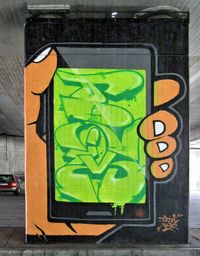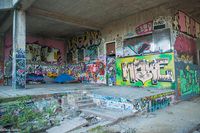LOCATIONS - All LOCATION pages are still under construction!
Years below the pictures are either the graffito production date or the date the photograph was taken.
ALABAMA HALLE
In the 1980s, the Alabama Hall was a hotspot for international and local artists, having concerts and cultural events.
BAHNWÄRTER THIEL
Bahnwärter Thiel is a popular alternative cultural centre in Munich located at the Viehhof grounds. It is known for its unique concept of repurposing containers for use by artists.
BAYERSTRASSE
GEORG ELSER
BRUDERMÜHLBRÜCKE
The Brudermühl bridge is located in the south of Munich and connects the two districts of Sendling and Untergiesing. Since 1996, the bridge's twelve pillars (covering an area of ca. 400 square metres) have been sprayed with graffiti regularly by artists as part of the ISART project.
BÜRGERPARK OBERFÖHRING
CANDIDPLATZ
DONNERSBERGERBRUECKE
The Donnersbergerbrücke, large bridge that connects the districts of Neuhausen and Schwanthalerhöhe, spanning railway tracks, Landsberger Straße, and Arnulfstraße.
The underpass, originally used as a parking lot, was identified as an ideal canvas for street art due to its large concrete surfaces. The gallery showcases a diverse range of graffiti styles, from abstract lettering to figurative murals.
FRIEDENSENGEL
HEIMERANPLATZ
The former Hall of Fame in the 1990s was located directly at Hansastrasse on the Feierwerk grounds.
KARL KOHL
KREATIVQUARTIER
The Kreativquartier (Creative Quarter) in Munich is an urban development project transforming a 20-hectare former military and industrial site into a mixed-use neighbourhood. Located northwest of Munich’s Altstadt, it aims to integrate living, working, art and culture into a dynamic, innovative setting.
OLYMPIA S-BAHN
Subway station built for the 1972 Olympics in Munich, opened in May 1972 to serve the Olympiapark facilities. After the games, it was used sparingly for events until its last operation during the 1988 UEFA Championship. Decommissioned thereafter, its tracks were cut in 2003 leaving it abandoned. Now a "ghost station" under heritage protection, it’s overgrown and graffitied, with no active rail use.
RIEM
SIEMENS GROUNDS
In the summer of 2017, the open-air gallery Scale Art Munich was created on the former Siemens grounds in Sendling.
"Urban art conquers public space, works with and within the visual outer layers of the city, intervenes with its full impulsive vitality and often also poetic melancholy into the urban landscape."
(Daniel Man)
"This mural is based on an image taken in 1945 of the atom bomb in Hiroshima, Japan. The concept of this wall takes a more objective or anthropological standpoint with the effort of understanding our nature through this manmade landscape. Harmony alludes to our misconception of what is natural or harmonious. We take our self out of the picture, or define our worst behavior as unnatural or disrupting harmony. But we partake in composing the term, inevitably we are a part of the ecosystem and therefor inherently natural and harmonious.
Formally, this mural is a juxtaposition of our interpretation from the same image, with the intention of creating a dialogue between them".
(SatOne)
ST. MARTINSTRASSE
SUGAR MOUNTAIN
Sugar Mountain was a temporary art and culture project in Munich’s Obersendling district, operating from 2021 to 2023 on the site of a former concrete factory. It featured a mix of street art, graffiti, music, theater, sports, and community events across 7,500 m² outdoor and 2,000 m² indoor spaces.
THALKIRCHNER STREET
TUMBLINGER STREET
Tumblingerstrasse is widely known as an important hub for street art and graffiti, located in the Schlachthof district next to Bahnwärter Thiel. Since the mid-80s it has been a relevant meeting place for artists - and since the early 90s it has become an internationally known legal Hall of Fame. Meanwhile, the Tumblingerstrasse (and the surrounding areas Thalkirchnerstrasse, the Viehof and Bahnwärter Thiel) organize spray events with local and international artists.
VIEHHOF
Located behind the walls of Tumblinger Street and Bahnwärter Thiel, the Viehhof grounds are a cornerstone of the city's graffiti culture. Historically, the site was part of the Schlachthof, a centralized slaughterhouse and livestock market established in 1878. Today, it is a graffiti hotspot attracting artists from all over the world.
WERKSVIERTEL
The Werksviertel is an arts district that hosts a variety of cultural events and exhibitions, including concerts, performances and art festivals. Once an industrial area housing the Pfanni potato product factory, the site evolved in the 1990s into a nightlife hub with the Kunstpark Ost and Kultfabrik, where graffiti artists from around the world painted the abandoned factory walls. Since the early 2010s, the area has been redeveloped into a creative, mixed-use neighborhood, blending residential, commercial, and cultural spaces while preserving its legacy as a street art mecca. Co-ordinated by Loomit and home to events such as the Hands Off The Wall Festival, the Werksviertel showcases a diverse range of works by local and international artists.





-2.jpg/picture-200?_=19472de5ba6)
-2.jpg/picture-200?_=19472de5efa)
.jpg/picture-200?_=19695c02f0c)
-3.jpg/picture-200?_=197ba955bc0)
.jpg/picture-200?_=197ba8ba760)
-2.jpg/picture-200?_=197ba905698)









.jpg/picture-200?_=196998cce00)
-2.jpg/picture-200?_=19715e89308)


.jpg/picture-200?_=197c036dd5d)
.jpg/picture-200?_=196998cd1e8)
.jpg/picture-200?_=19699faa718)
.jpg/picture-200?_=1969e8d5c52)



-2.jpg/picture-200?_=197c036411a)











































.jpg/picture-200?_=197bcc32974)
.jpg/picture-200?_=1970abe597a)
.jpg/picture-200?_=1970abe5cb0)
.jpg/picture-200?_=1970abe5632)
.jpg/picture-200?_=197bcc3d0ab)
.jpg/picture-200?_=197bcc32c70)



























.jpg/picture-200?_=197c461e054)
.jpg/picture-200?_=197c461dce7)

_1.jpg/picture-200?_=19355a3f220)




-2.jpg/picture-200?_=193556c8a88)